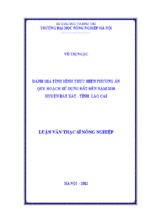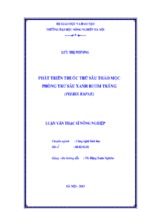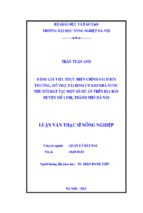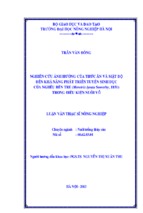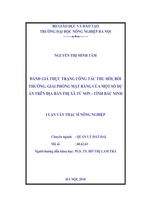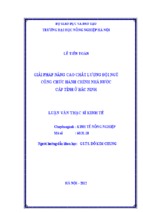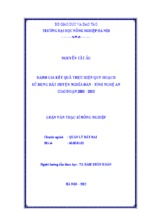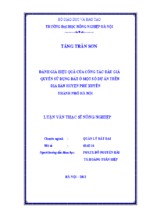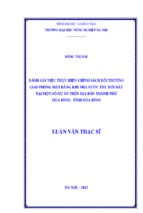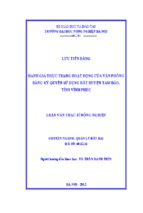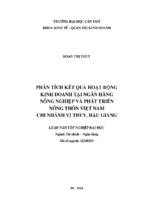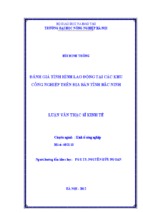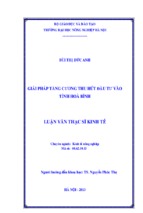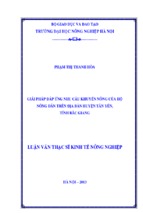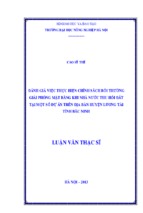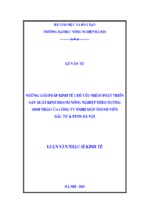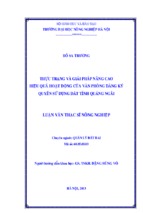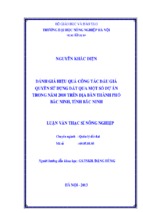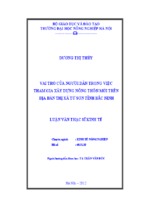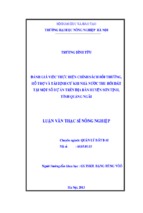國立屏東科技大學熱帶農業暨國際合作系
Department of Tropical Agriculture and International Cooperation
National Pingtung University of Science and Technology
博士學位論文
Ph.D. Dissertation
草藥 (龍牙草、鱧腸、仙草、地耳草、甜珠草及曲序香茅)之栽
培及生物活性研究
Study in Cultivation and Bioactivities of Herbs Agrimonia pilosa,
Eclipta alba, Mesona procumbens, Hypericum japonicum, Scoparia
dulcis, and Cymbopogon flexuosus
指導教授 Advisors: 吳明昌博士(Ming-Chang Wu, Ph.D.)
賴宏亮博士(Horng-Liang Lay, Ph.D.)
研究生 Student: 黎光鷹 (Le Quang Ung)
中華民國 108 年 6 月 15 日
June 15, 2019
摘要
學號:P10422023
論文題目: 草藥 (龍牙草、鱧腸、仙草、地耳草、甜珠草及曲序香茅)之栽
培及生物活性研究
總頁數:138 頁
學校名稱:國立屏東科技大學
系(所)別:熱帶農業暨國際合作系
畢業時間及摘要別:107 學年度第 2 學期博士學位論文摘要
研究生: 黎光鷹
指導教授: 吳明昌 博士
賴宏亮 博士
論文摘要內容:
本次研究中選擇六種受關注的傳統中草藥應用於天然產品。該研究
選用五項體外實驗進行研究。第一項目的為探討蚯蚓糞(VC)和豬糞肥對
龍牙草(Agrimonia pilosa Ledeb.)生長、產量和化學成分含量的影響。
其他四項研究目的為研究龍牙草 (Agrimonia pilosa Ledeb.)提取物的抗氧
化活性以及對 HepG2(人類肝癌細胞)和 A549(人類肺癌細胞)的生
長抑製效果。鱧腸( Eclipta alba Hassk.)、仙草(Mesona procumbens
Hemsl.) 、 地 耳 草 ( Hypericum japonicum Thunb. ) 、 甜 珠 草 (Scoparia
dulcis L.)和曲序香茅(Cymbopogon flexuosus (Nees ex Steud.) W. Watson)
以乙醇萃取後進行實驗。實驗項目為總酚和類黃酮含量以及包含總抗氧
化能力(ABTS)、清除自由基能力(DPPH)以及羥自由基清除能力等抗氧
化實驗。在某些實驗中還評估了培養基中的乳酸脫氫酶含量。並利用高
效液相色譜(HPLC)方法用於分析龍牙草(Agrimonia pilosa Ledeb.)、
鱧腸(Eclipta alba Hassk.)、仙草(Mesona procumbens Hemsl.) 、 地耳
草(Hypericum japonicum Thunb.)及 甜珠草 (Scoparia dulcis L.) 中的酚
類 化 合 物 。 另 外 透 過 質 譜 儀 (MS) 和 核 磁 共 振 (NMR) 建 立 曲 序 香 茅
(Cymbopogon flexuosus (Nees ex Steud.) W. Watson) 的化學結構和地上部
I
分的外部特徵。並透過西方墨點法分析凋亡因子 bcl-2、bax、bad、
caspase-3、caspase-9 和 p53 蛋白。
結果表明、對於第一項研究(1)、施用有機肥料增強了龍牙草
(Agrimonia pilosa Ledeb.)的生長、產量和化學成分含量。 pH 值在 6.9
和 7.4 之間、導電率(EC)從 0.5-0.6mS cm-1 為此種草藥生長的最佳條件。
蚯蚓糞(VC)和豬糞的最佳比例為 12.5 + 16.875 ton ha-1 的比例製成。這一
結果表明、使用有機肥料可以提升其他草藥的生長、產量和化學成分含
量 、 並進 行 進一步 的 詳細 調 查。在 第 二項 研 究( 2) 中 、在 龍 牙草
(Agrimonia pilosa Ledeb.)萃取物中鑑定出由 4-羥基苯甲酸和對香豆酸
組成的兩種單獨的酚類化合物。與地上部分萃取物相比、根部萃取物有
更高的抗氧化力及 A549 細胞生長抑制能力。在第三項研究(3)中、鱧
腸(Eclipta alba Hassk.)萃取物經鑑定過後得知含有 4-羥基苯甲酸、咖
啡酸、對香豆酸和迷迭香酸等化合物。仙草(Mesona procumbens Hemsl.)
萃取物經鑑定過後得知含有 7-羥基香豆素、阿魏酸和芸香苷是新化合物
和兩種已知化合物。從鱧腸(Eclipta alba Hassk.)萃取物中檢測到較高
清除自由基能力(DPPH)和總抗氧化能力(ABTS)及抗癌活性。在第四項
研 究 ( 4 ) 中 、 綠 原 酸 和 迷 迭 香 酸 是 地 耳 草 ( Hypericum japonicum
Thunb.)萃取物經鑑定後所得知的化合物。芸香苷和迷迭香酸是從甜珠
草(Scoparia dulcis L.)萃取物中新測得的化合物。地耳草(Hypericum
japonicum Thunb.)萃取物有更高水平的抗氧化和抗癌能力。最後的研究
(5)、1,3-O-二-E-咖啡酰甘油(SA3)和 1-O-p-香豆酰-3-O-咖啡酰甘
油(SA4)兩者為從曲序香茅(Cymbopogon flexuosus (Nees ex Steud.) W.
Watson) 萃取物中分離出來化合物。 SA3 化合物擁有最高的抗氧化力和
抗癌能力。
根據本次實驗結果顯示有些中草藥可能有助於為癌症疾病患者開發
新型天然藥物、還可以進一步了解草藥的功能和分子機制。製作龍牙草
( Agrimonia pilosa Ledeb. ) 、 鱧 腸 ( Eclipta alba Hassk. ) 、 地 耳 草
(Hypericum japonicum Thunb.)、曲序香茅(Cymbopogon flexuosus (Nees
ex Steud.) W. Watson) 的機能性食品或營養補充品的膠囊。
關 鍵 字 : 抗 癌 、 龍 牙 草 、 曲 序 香 茅 、 鱧 腸 、 地 耳 草
II
Abstract
Student ID: P10422023
Title of Dissertation: Study in Cultivation and Bioactivities of Herbs
Agrimonia pilosa, Eclipta alba, Mesona procumbens,
Hypericum japonicum, Scoparia dulcis, and
Cymbopogon flexuosus
Total Page: 138 pages
Name of Institute: Department of Tropical Agricultural and International
Cooperation, National Pingtung University of Science
and Technology
Graduate Date: June15, 2019
Name of Student: Le Quang Ung
Degree Conferred: Doctoral Degree
Advisors: Ming-Chang Wu, Ph.D.
Horng-Liang Lay, Ph.D.
The content of abstract in this dissertation:
Six herbs chosen in this work have received considerable attention as
natural products for their applications in traditional medicine. The study
consists of five studies being conducted under in vitro conditions. The first
study aims to investigate effects of vermicompost and hog manure on growth,
yield, chemical composition of Agrimonia pilosa Ledeb. Four other studies
aim to investigate antioxidant activities, HepG2 (human liver cancer cell line)
and A549 (adenocarcinomic human alveolar basal epithelial cell line) growth
inhibitory effect from extracts of Agrimonia pilosa Ledeb. Eclipta alba Hassk.
Mesona procumbens Hemsl. Hypericum japonicum Thunb. Scoparia dulcis
L.and Cymbopogon flexuosus (Nees ex Steud.) W. Watson. Extracts of
ethanol were chosen for the assays. Total phenolic and flavonoid content and
the antioxidant activities comprising ABTS+, DPPH, hydroxyl radical
III
scavenging systems were determined. Lactate dehydrogenase release in
medium was also evaluated in some experiments. High performance liquid
chromatography (HPLC) method was used to analysize phenolic compounds
from Agrimonia pilosa Ledeb. Eclipta alba Hassk. Mesona procumbens
Hemsl. Hypericum japonicum Thunb. Scoparia dulcis L. Chemical structural
characterization from the aerial parts of Cymbopogon flexuosus was
established by MS and NMR spectra techniques.The apoptotic factors bcl-2,
bax, bad, caspase-3 and caspase-9, p53 were analyzed by western blotting
assays.
The results showed that, for the first study (1), application of ogarnic
fertilizers enhanced the morphological growth, yield, chemical composition
of Agrimonia pilosa Ledeb. The pH between 6.9 and 7.4, EC from 0.5-0.6 mS
cm-1 are optimal for this herbal growth. A mixture of the Vermicompost and
Hog manure made with the rate of 12.5 + 16.875 ton ha -1 produced best
parameters. This result suggests that using of organic fertilizers could
completely enhance the morphological growth, yield, chemical composition
of other herbs and futher detailed investigations are in progress. In the second
study (2), two individual phenolic compounds consisting of 4-hydroxybenzoic
acid and p-coumaric acid were firstly identified from Agrimonia pilosa Ledeb.
The root extract exhibited higher antioxidant and A549 inhibitory capacity
compared to the aerial part extract. In the third study (3), the 4hydroxybenzoic acid, caffeic acid, p-coumaric acid and rosmarinic acid were
the identified compounds in Eclipta alba Hassk. The 7-hydroxycoumarin,
ferulic acid and rutin being new compounds and two known compounds were
identidied in the Mesona procumbens Hemsl. The higher levels of DPPH and
ABTS+ radical scavenging and anticancer activities were detected from
Eclipta alba Hassk. In the fourth study (4), the chlorogenic acid and
rosmarinic acid were the identified compounds in the Hypericum japonicum
Thunb. The rutin and rosmarinic acid were newly identified compound from
the Scoparia dulcis L. The higher levels of antioxidant and anticancer
IV
capacity were detected from Hypericum japonicum Thunb. The last study (5),
1,3-O-di-E-caffeoylglycerol
(SA3)
and
1-O-p-coumaroyl-3-O-
caffeoylglycerol (SA4) were firstly isolated from Cymbopogon flexuosus
(Nees ex Steud.) W. Watson. The SA3 compound showed the highest
antioxidant and anticancer potent.
The information obtained from this work will likely contribute to the
development of novel natural medicine for cancer diseasers. It will also
provide new insights for the futher understanding of the functions and
molecular mechanism of herbs. An insightful investigation to establish and
manufacture capsules used as function and supplemental food from
Agrimonia pilosa Ledeb. Eclipta alba Hassk. Hepericum japonicum Thunb.
Cymbopogon flexuosus (Nees ex Steud.) W. Watson was recommended.
Keywords: anticancer, Agrimonia pilosa Ledeb, Cymbopogon flexuosus
(Nees ex Steud.) W. Watson, Eclipta alba Hassk, Hypericum
japonicum Thunb
V
Acknowledgements
I would like to express sincere thanks to my two advisors, Professor Dr.
Ming-Chang Wu and Professor Dr. Horng-Liang Lay, for their invaluable
guidance on my research. I greatly appreciate their intellectual instructions,
kindness, and supports during my Ph.D. research program.
I would like to thank the advisory committee members for their valuable
comments and constructive suggestions for the successful completion of this
research work.
I am grateful to Taiwan Scholarship (Ministry of Education) for budget
support for my Ph.D. program in Taiwan. I would also like to thank NPUST,
DTAIC for offering me this good opportunity to pursue my doctoral study.
I would like to thank the personnel of the Department of Tropical
Agriculture and International Cooperation; Office of International Affair,
Chinese Herbal Medicine and FP201 Laboratory for their help during this
study program.
Lastly, I would like to thank my parents for their confidence and love;
my colleague, my friends for their encouragement and affection and
especially my wife who was always there with wisdom, inspiration and cheer.
VI
Table of Contents
摘要 ................................................................................................................... I
Abstract ......................................................................................................... III
Acknowledgements ........................................................................................VI
Table of Contents ........................................................................................ VII
List of Tables.............................................................................................. XIII
List of Figures .............................................................................................. XV
List of Abbreviation ............................................................................... XVIII
Chapter 1 Introduction ................................................................................... 1
1.1 Research background ............................................................................... 1
1.2 Research objectives ................................................................................... 3
Chapter 2 Literature Review ......................................................................... 4
2.1 Herbs used in the study............................................................................. 4
2.1.1 Agrimonia pilosa Ledeb. (AL) ............................................................... 4
2.1.1.1 Botany ............................................................................................. 4
2.1.1.2 Chemical composition in AL .......................................................... 5
2.1.1.3 Pharmacological activities and the use of AL in traditional
medicine...................................................................................................... 5
2.1.2 Eclipta alba Hassk (EH) ......................................................................... 6
2.1.2.1 Botany ............................................................................................. 6
2.1.2.2 Chemical composition in EH ......................................................... 7
2.1.2.3 Pharmacological activities and the use of EH in traditional
medicine...................................................................................................... 7
2.1.3 Mesona procumbens Hemsl (MH) ......................................................... 7
2.1.3.1Botany .............................................................................................. 7
VII
2.1.3.2 Chemical composition in MH......................................................... 8
2.1.3.3 Pharmacological activities and the use of MH in traditional
medicine...................................................................................................... 8
2.1.4 Hypericum japonicum Thunb (HT)....................................................... 9
2.1.4.1 Botany ............................................................................................. 9
2.1.4.2 Chemical composition in HT ........................................................ 10
2.1.4.3 Pharmacological activities and the use of HT in traditional
medicine.................................................................................................... 10
2.1.5 Scoparia dulcis L. (SL) ......................................................................... 10
2.1.5.1 Botany ........................................................................................... 10
2.1.5.2 Chemical composition in SL ......................................................... 11
2.1.5.3 Pharmacological activities and the use of SL in traditional
medicine.................................................................................................... 11
2.1.6 Cymbopogon flexuosus (Nees ex Steud.)W. Watson (CF)................. 12
2.1.6.1 Botany ........................................................................................... 12
2.1.6.2 Chemical composition in CF ........................................................ 12
2.1.6.3 Pharmacological activities and the use of CF in traditional
medicine.................................................................................................... 13
2.2 Application of organic materials in plant cultivation .......................... 13
2.3 The chemistry of phenolic compounds .................................................. 16
2.3.1 Phenolic acid ......................................................................................... 17
2.3.2 Flavonoids ............................................................................................. 17
2.3.3 Tannins .................................................................................................. 20
2.4 Quantification of phenolics..................................................................... 20
2.4.1 Spectrophotometric assays .................................................................. 20
2.4.2 High performance liquid chromatogaraphy (HPLC) ....................... 21
VIII
2.5 Antioxidants ............................................................................................. 22
2.5.1 What is an antioxidant? ....................................................................... 22
2.5.2 Basics of antioxidant characterization ............................................... 23
2.5.3 Reactive oxygen species ....................................................................... 23
2.5.4 Antioxidant assay ................................................................................. 24
2.5.5 Synthetic phenolic and natural antioxidants ..................................... 24
2.6 Introduction of cancers ........................................................................... 25
2.6.1 Cancer.................................................................................................... 25
2.6.2 Introduction of human tumor cell lines ............................................. 26
2.7 Introduction of apoptosis ........................................................................ 27
2.7.1 What is apoptosis?................................................................................ 27
2.7.2 Bcl-2 family protein in apoptosis ........................................................ 28
2.7.3 Caspases in apoptosis ........................................................................... 29
2.7.4 Effects of antioxidants on cancer ........................................................ 29
Chapter 3 Research Methodology ............................................................... 32
3.1 The study setup ........................................................................................ 32
3.1.1 Study 1 ................................................................................................... 32
3.1.2 Study 2 ................................................................................................... 32
3.1.3 Study 3 ................................................................................................... 32
3.1.4 Study 4 ................................................................................................... 32
3.1.5 Study 5 ................................................................................................... 32
3.2 Plant cultivation of Agrimonia pilosa Ledeb ......................................... 33
3.3. Preparation of samples .......................................................................... 35
3.4 Determination of total phenolic and flavonoid contents ..................... 36
IX
3.5 Component ananalysis by high performance liquid chromatography
(HPLC) ........................................................................................................... 38
3.5.1 The following gradients for study 2 .................................................... 38
3.5.2 The following gradients for study 3 .................................................... 39
3.5.3 The following gradients for study 4 .................................................... 39
3.5.4 Calibration curve method.................................................................... 40
3.6 Bioactivitie assays .................................................................................... 40
3.6.1 Antioxidant activities ........................................................................... 40
3.6.2 Anticancer activities ............................................................................. 42
3.6.2.1 Cell line resouce ........................................................................... 42
3.6.2.2 Cell culture and treatments .......................................................... 43
3.6.2.3
Analysis of cell morphology change ......................................... 46
3.6.2.4
Cell viability assay (MTT assay) ............................................... 47
3.6.2.5
Lactate dehydrogenase (LDH) released determination ............ 48
3.6.2.6
Western blotting assay .............................................................. 49
3.7
Statistical analysis ................................................................................ 53
Chapter 4 Results and Discussion................................................................ 54
4.1
Study 1: Effects of vermicompost and hog manure on growth, yield,
chemical composition of Agrimonia pilosa Ledeb. ..................................... 54
4.1.1 Chemical and physical characterization of media ............................ 54
4.1.2
Morphological parameters of Agrimonia pilosa Ledeb................. 55
4.1.3 Effects of fertilizer on total phenolic and flavonoid content and
antioxidant capacity of Agrimonia pilosa Ledeb ................................. 61
4.1.4 Conclusion ............................................................................................. 62
X
4.2.
Study 2: Antioxidant activities and A549 cells growth inhibitory
capacity from 50% ethanol extracts of various parts of Agrimonia pilosa
Ledeb. 64
4.2.1 Total phenolic and flavonoid content ................................................. 65
4.2.2 Antioxidant properties ......................................................................... 65
4.2.3 High performance liquid chromatography (HPLC) analysis .......... 68
4.2.4 Extracts affecting growth in A549 cells.............................................. 68
4.2.5
Conclusion ......................................................................................... 72
4.3 Study 3: Antioxidant activities and HepG2 cells growth inhibitory
capacity of whole plant 50% ethanol extracts (Eclipta alba Hassk and
Mesona procumbens Hemsl) ......................................................................... 73
4.3.1 Total phenolic and flavonoid content ................................................. 74
4.3.2 Antioxidant properties ......................................................................... 74
4.3.3 Phenolic identification by high performance liquid chromatography
................................................................................................................... 76
4.3.4 EH and MH extracts affecting growth in HepG2 cells...................... 77
4.3.5 Conclusion ............................................................................................. 83
4.4 Study 4: Evaluation of antioxidant and HepG2 and A549 cells growth
inhibitory capacity of whole plant 50 % ethanol extracts (Hypericum
japonicum Thunb and Scoparia dulcis L) .................................................... 84
4.4.1 Total phenolic (TPC) and flavonoid content (TFC).......................... 84
4.4.2 Phenolic identification by high performance liquid chromatography
................................................................................................................... 85
4.4.3
Antioxidant properties ..................................................................... 85
4.4.4 The HT and SL extracts affecting growth in HepG2 and A549 cells
................................................................................................................... 89
XI
4.4.5 The HT altered the expression of apoptosis-related proteins in
HepG2 and A549 cells ............................................................................ 89
4.4.6 Conclusion ............................................................................................. 92
4.5 Study 5: The isolation, structural characterization and anti-cancer
activity from the aerial parts of Cymbopogon flexuosus (Nees ex Steud.)
W. Watson. ..................................................................................................... 93
4.5.1 Total phenolic and flavonoids content ............................................... 93
4.5.2 Antioxidant properties ......................................................................... 98
4.5.3 SA3, SA4 and CF extract affecting growth in HepG2 and A549 cells
......................................................................................................................... 98
4.5.4 Conclusion ........................................................................................... 101
Chapter 5 Conclusions and Recommendations ........................................ 103
5.1 Conclusions ............................................................................................ 103
5.1.1
Application of organic fertilizer in Agrimona pilosa Ledeb
cultivation .............................................................................................. 103
5.1.2 Chemical compounds isolated from the studied herbs ................... 103
5.1.3
Antioxidant potential of the studied herbs ................................... 104
5.1.4 Anticancer potential of the studied herbs ........................................ 104
5.2 Limitations ............................................................................................. 104
5.3 Future study ........................................................................................... 105
References .................................................................................................... 107
Appendices ................................................................................................... 135
Bio-Sketch of Author .................................................................................. 136
XII
List of Tables
Table 1.Classes of phenolic compounds in plants .......................................... 18
Table 2. Composition of transfer buffer (pH 8.4-9.2, 1L) .............................. 52
Table 3. Component of TBST-1L ................................................................... 52
Table 4. Component of sperating gel (2 gels) ................................................. 52
Table 5. Component of stacking gel (2 gels) .................................................. 52
Table 6. Chemical and physical characteristics of different vermicompost rate
mixture with hog manure ................................................................................ 57
Table 7. Effects of different fertilizer rates on the morphological growth of
Agrimonia pilosa Ledeb. after 120 days ......................................................... 58
Table 8. Effects of different fertilizer rates on the morphological growth of
Agrimonia pilosa Ledeb. after 120 days ......................................................... 58
Table 9. Effects of different fertilizer rates on total phenolic content and
antioxidant activity of Agrimonia pilosa Ledeb. ............................................ 59
Table 10. Pearson correlation between macro- and micro nutrients and herbal
quality of Agrimonia pilosa Ledeb ................................................................. 59
Table 11. Various extracts induced growth inhibition in A549 cells ............. 69
Table 12. DPPH free radical scavenging activities of EH and MH ................ 75
Table 13. The contents of phenolic components of EH and MH.................... 79
Table 14. The EH and MH extracts induced growth inhibition in HepG2 ..... 79
XIII
Table 15. Phenolic contents, flavonoid contents and antioxidant activities of
the HT and SL extracts .................................................................................... 87
Table 16. Total phenolic and flavonoid contents obtained by different solvents
......................................................................................................................... 95
Table 17. 1H (500 MHz) and 13C-NMR (125 MHz) data for compounds SA3
and SA4 ........................................................................................................... 95
Table 18. The antioxidant effects and cytotoxicity of compounds SA3, SA4
and ethanol 50% extract against two cancer cell lines .................................. 100
XIV
List of Figures
Figure 1. The herbs used in study. Agrimonia pilosa Ledeb (a); Eclipta alba
Hassk. (b); Mesona procumbens Hemsl. (c); Hypericum japonicum Thunb.
(d); Scoparia dulcis L. (e); and Cymbopogon flexuosus (Nees ex Steud.) W.
Watson.(f). ....................................................................................................... 15
Figure 2. Examples of hydroxybenzoic acid (a) and hydroxycinnamic acid (b)
......................................................................................................................... 18
Figure 3. Generic structure of a flavonoid molecule ...................................... 19
Figure 4. Structure of hydrolyzable (a) and condensed tannins (b) (Luthar,
1992) ................................................................................................................ 19
Figure
5.
Antioxidant
behavior
(Source:http://multimmunity.com/wp-
content/uploads/2013/11/antioxidant-c60.jpg) ............................................... 19
Figure 6. Summary of the extrinsic and intrinsic pathway in apoptosis ......... 31
Figure 7. The schematic diagram of SA3 and SA4 compounds isolation from
ethyl acetate fraction ....................................................................................... 37
Figure 8. Dry material yield per ha after 120 days planting of Agrimonia
pilosa Ledeb .................................................................................................... 60
Figure 9. ABTS+ radical scavenging activity in the presence of the standard
(BHT) and in samples of Agrimonia pilosa Ledeb ......................................... 66
Figure 10. DPPH radical scavenging activity in the presence of the standard
(BHT) and in samples of Agrimonia pilosa Ledeb.a-bvalues (mean ± SD) with
different small letters were significantly different at P less than 0.01 (n=3) at
the same time and concentration. .................................................................... 66
XV
Figure 11. HPLC chromatograms of phenolic components of AL (A) standard
phenolic, (B) peaks of aerial parts, (C) peaks of root: (1) 4-hydroxybenzoic
acid; (2), chlorogenic acid; (3), p-coumaric acid ............................................ 69
Figure 12. LDH release in cell culture supernatant of different concentration
from various extracts of Agrimonia pilosa on A549 after 24 hr treatment.
a-
c
values (mean±SD) with different small letter being significantly different at
the same concentration. ................................................................................... 71
Figure 13. The RE activated apoptosis-related proteins (caspase-3, caspase-9,
bcl-2, bax and bad) A549 cells after 24hr ....................................................... 71
Figure 14. DPPH free radical scavenging activities of EH and MH .............. 78
Figure 15. HPLC chromatograms of phenolic components of EH ................. 78
Figure 16. HPLC chromatograms of phenolic components of MH ................ 81
Figure 17. LDH released in cell culture supernatant of different concentration
ofEH and MH compared to BHA.................................................................... 81
Figure 18. EH and MH altered the expression of apoptosis –related proteins in
HepG2 cells after 24 hr ................................................................................... 82
Figure 19. HepG2 cells morphology after injured by different concentrations
of the EH after 24 hr treatment (A) without sample, (B) 62.5 µg/mL, (C) 500
µg/mL, (D) 750 µg/mL ................................................................................... 82
Figure 20. (a) HPLC chromatograms of phenolic components of the HT; AStandard phenolic peaks: (1), 4-hydroxybenzoic acid; (2), chlorogenic acid;
(3), benzoic acid; (4), p-coumaric acid; (5), caffeic acid; (6), ferulic acid; (7),
rosmarinic acid; B- Sample phenolic peaks. ................................................... 86
Figure 21. ABTS+ radical scavenging capacity of the HT, SL, and BHT ..... 88
XVI
Figure 22. DPPH radical scavenging capacity of the HT, SL, and BHT........ 88
Figure 23. Hydroxyl radical scavenging capacity of the HT, SL, and BHT .. 88
Figure 24. The HT and SL extracts induced growth inhibition in HepG2 after
24 hr (A) and after 48 hr (B); in A549 after 24 hr (C) and after 48 hr (D) ..... 90
Figure 25. The HT altered the expression of apoptosis-related protein
(caspase-3, caspase-9, bcl-2 and bad) in HepG2 after 24 hr ........................... 91
Figure 26. The HT altered the expression of apoptosis-related protein
(caspase-3, bad, bax, p53) in A549 cells after 24 hr ....................................... 91
Figure 27. Mass spectrum of compounds SA3 and SA4 ................................ 96
Figure 28. Chemical structure of compounds SA3 (a) and SA4 (b) ............... 96
Figure 29. ABTS+ radical scavenging capacity of the E50, SA3, SA4, and
BHT.
a-b
values (mean ± SD) with different small letters were significantly
different at P less than 0.01 (n=3) at the same time and concentration .......... 99
Figure 30. DPPH radical scavenging capacity of the E50, SA3, SA4, and
BHT ................................................................................................................. 99
Figure 31. SA3 altered the expression of apoptosis- related proteins caspase-3,
bax, bcl-2 in HepG2 (A) and caspase-3, caspase-9, p53 in A549 cells (B) after
24 hr ............................................................................................................... 100
XVII
List of Abbreviation
AL
AE
ABTS+
CF
DAT
DNA
DPPH
dw
EH
EC
HM
HT
hr
I.D
iNOS
L
MH
OD
OM
RE
SAS
SL
T
UV
VC
v
w
%
g
mg
µg
mL
µL
min
mm
Agrimonia pilosa Ledeb.
Aerial parts extract
2,2’-azino-bis(3-ethylbenzothiazoline-6-sulphonic acid
Cymbopogon flexuosus (Nees ex Steud.) W. Watson.
Days after transplanting
Deoxyribonucleic acid
1,1-diphenyl-2-picrylhydrazyl
Dry weigh
Eclipta alba Hassk.
Electrolyte conductivity
Hog manure
Hypericum japonicum Thunb.
Hour
Internal Diameter
Inducible nitric oxide
Litter
Mesona procumbens Hemsl.
Optical density
Organic matter
Root extract
Statistical Analysis System
Scoparia dulcis L.
Treatment
Ultraviolet
Vermicompost
Volume
weigh
Percentage
Gram
Milligram
Microgram
Millilitre
Microlitre
Minutes
Millimetres
XVIII
Chapter 1
Introduction
1.1 Research background
Free radicals can be generated in biological systems in the form of
reactive oxygen species (ROS) (Halliwell et al., 1995). They comprise
various forms of activated oxygen including superoxide radicals, hydroxyl
radicals, hydrogen peroxide, and nitric oxide, which often are generated as
products of biologic reactions or from exogenous factors (Pan et al., 2008).
High free radical levels or oxygen species create oxidative stress (Ordonez et
al., 2006). The ROS had been implicated in the etiology of various chronic
diseases such as Alzheimer’s and Parkinson’s diseases (Uttara et al., 2009);
cancer, diabetes and obesity (Ames et al., 1993). In order to protect human
beings against oxidative damage, synthetic antioxidants such as butylated
hydroxytoluene (BHT) and butylated hydroxyanisole (BHA) were created due
to demand. However, there has been concern regarding the toxicity and
carcinogenic effects of synthetic antioxidants. The identification of new safe
and inexpensive antioxidant sources being of natural origin is necessary.
Therefore, in the recent decades many herbs have been commodiously studied
for their antioxidant activity and radical scavenging activity (De las heras et
al., 1998; Schinella et al., 2002; Vanderjagt et al., 2002), and much attention
has been focused on exploring therapeutic compounds. Natural products are
excellent sources of therapeutic compounds. It is particularly evident in
cancer therapy where more than 60% of approved drugs are of natural origin
(Newman et al., 2003). Therefore, a new natural source of anti-cancer
compounds would be a valuable tool in cancer therapy.
Cancer currently remains a very serious disease and is one of the major
causes of death in the world. The factor of cancer disease included people’s
lifestyle, environmental factors, and the most important are dietary factors
1
- Xem thêm -

